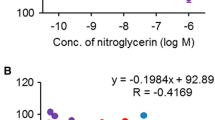Abstract
In 11 open-chest dogs with a flowmeter on the left circumflex artery, L-NMMA, a selective inhibitor of nitric oxide-formation, was subselectively infused into the left circumflex artery at a rate of 2.5mg/ml (ml/min) to avoid systemic hemodynamic effects. The coronary blood flow at normal arterial blood pressure was similar prior to and during L-NMMA infusion. However, when the arterial blood pressure was raised by inflating a balloon in the descending aorta, the nitric oxide suppression induced a dramatic increase in coronary vascular resistance by almost 40% compared to control conditions without L-NMMA infusion at identically elevated arterial blood pressure. L-NMMA induced a significant downward shift and flattening of the pressure-flow relation over a pressure range from 60–150 mmHg. Peak hyperemic coronary flow after 20-s transient coronary occlusion was similar prior to and during L-NMMA infusion, but the duration of the hyperemic flow response was significantly shortened during L-NMMA infusion indicating exaggerated constriction after hyperemic stimulus. The EDRF/nitric oxide-system plays an important role for the regulation of coronary blood flow by counteracting autoregulatory constrictor responses to increased driving pressure and shear stress in the intact canine circulation.
Similar content being viewed by others
References
Altmann JD, Kinn J, Dunker DJ, Bache RJ (1994) Effect of inhibition of nitric oxide formation on coronary blood flow during exercise in the dog. Cardiovasc Res 28: 119–124
Berne RM, Rubio R (1979) Coronary circulation. In: Handbook of Physiology. the Cardiovascular System, The Heart Am Physiol Soc, Baltimore, MD, pp 873–952
Chu A, Chambers DE, Lin C-C, Kuehl WD, Cobb FR (1990) Nitric oxide modulates epicardial coronary basal vasomotor tone in awake dogs. Am J Physiol 258: H1250-H1254
Chu A, Chambers DE, Lin C-C, Kuehl WD, Palmer RMJ, Moncada S, Cobb FR (1991) Effects of inhibition of nitric oxide formation on basal vasomotion and endothelium-dependent responses of the coronary arteries in awake dogs J Clin Invest 87: 1964–1968
Furchgott RF, Zawadzki JV (1980) The obligatory role of endothelial cells in the relaxation of arterial smooth muscle by acetylcholine. Nature 288: 373–376
Griffith TM, Edwards DH (1990) Myogenic autoregulation of flow may be inversely releated to endotheliumderived relaxing factor activity. Am J Physiol 258: H1171-H1180
Hwa JJ, Bevan JA (1986) Strech-dependent (myogenic) tone in rabbit ear resistance arteries. Am J Physiol 250: H87-H95
Ignarro LJ, Harbison RG, Wood KS, Kadowitz PJ (1986) Activation of purified soluble guanylate cyclase by endothelium-derived relaxing factor from intropulmonary artery and vein: stimulation by acetylcholine, bradykinin and arachidonic acid. J Pharmacol Exp Ther 237: 893–900
Myers PR, Minor RL Jr., Guerra R Jr., Bates JN, Harrison DG (1990) Vasorelaxant properties of the endotheliumderived relaxing factor more closely resemble S-nitrocysteine than nitric oxide. Nature 345: 161–163
Palmer RM, Ashton DS, Moncada S (1988) Vascular endothelial cells synthesize nitric oxide from L-arginine. Nature 333: 664–666
Palmer RM, Ferrige AG, Moncada S (1987) Nitric oxide accounts for the biological activity of endothelium-derived relaxing factor. Nature 327: 524–526
Rees DD, Palmer RMJ, Moncada S (1989) Role of endothelium-derived nitric oxide in the regulation of blood pressure. Proc Natl Acad Sci USA 86: 3357–3378
Rubanyi GM (1988) Endothelium-deri ved vasoconstrictor factors. In: Ryan US (ed) Endothelial Cell, CRC, Cleveland, OH, pp 61–74
Rubanyi GM (1988) Endothelium-dependent pressure-induced contraction of isolated canine carotid arteries. Am J Physiol 255: H783-H788
Smith TP Jr, Canty JM Jr (1993) Modulation of coronary autoregulatory responses by nitric oxide: Evidence for flow-dependent resistance adjustments in conscious dogs. Circ Res 73: 232–240
Vallance P, Collier J, Moncada S (1989) Effects of endothelium-derived nitric oxide on peripheral arteriolar tone in man. Lancet 2: 997–1000
Vane R, Anggard EE, Botting RM (1990) Regulatory functions of the vascular endothelium. N Engl J Med 323: 27–36
Yamabe H, Okumura K, Ishizaka H, Tsuchiya T, Yasue H (1992) Role of endothelium-derived nitric oxide in myocardial reactive hyperemia. Am J Physiol 263: H18-H14
Author information
Authors and Affiliations
Additional information
Supported in part by grant 1 RO1 HL-40865 from the National Heart, Lung, and Blood Institute. U.S. is the recipient of research grant So 241/1-1 from the Deutsche Forschungsgemeinschaft
Rights and permissions
About this article
Cite this article
Solzbach, U., Liao, J., Eigler, N.L. et al. Effects of inhibition of nitric oxide formation on the regulation of coronary blood flow in anesthetized dogs. Basic Res Cardiol 90, 489–497 (1995). https://doi.org/10.1007/BF00788542
Received:
Revised:
Accepted:
Issue Date:
DOI: https://doi.org/10.1007/BF00788542




